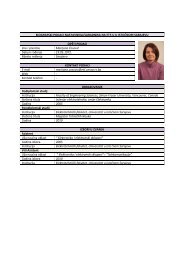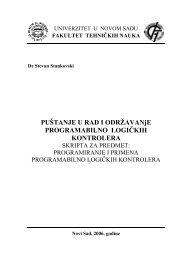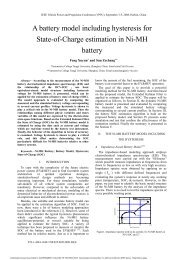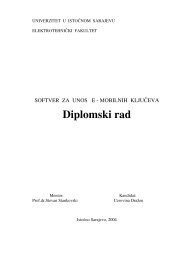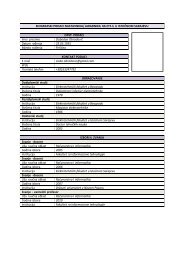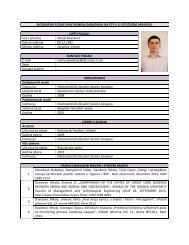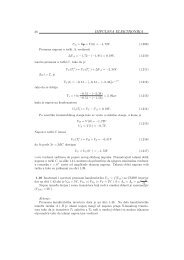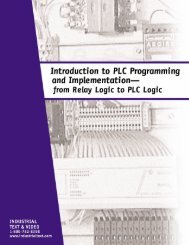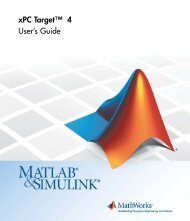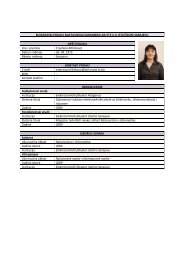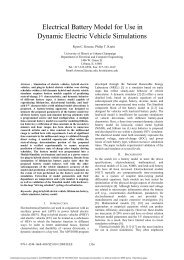parameter identification of the lead-acid battery model
parameter identification of the lead-acid battery model
parameter identification of the lead-acid battery model
Create successful ePaper yourself
Turn your PDF publications into a flip-book with our unique Google optimized e-Paper software.
Several <strong>lead</strong>-<strong>acid</strong> <strong>battery</strong> <strong>model</strong>s are conceived, forexample, <strong>the</strong> ma<strong>the</strong>matical <strong>model</strong> and <strong>the</strong> parallel branch<strong>model</strong>. But <strong>the</strong> third order <strong>model</strong> is <strong>the</strong> simplest one toidentify.As conclusion, all <strong>parameter</strong>s <strong>of</strong> this <strong>model</strong>, which isstudied in this paper, can be identified by laboratory testsor taken from <strong>the</strong> manufacturer's data. The third order<strong>model</strong> <strong>of</strong> <strong>the</strong> <strong>lead</strong>-<strong>acid</strong> has been validated by simulation on<strong>the</strong> s<strong>of</strong>tware Matlab/Simulink.REFERENCES[1] D. Linden et T. B. Reddy, "Handbook <strong>of</strong> Batteries", 3rdedition, McGraw-Hili, New York, NY, 2001.[2] Ceraolo, "New Dynamical Models <strong>of</strong> Lead-AcidBatteries", IEEE Transactions on Power Systems, vol.15, No.4, IEEE, November 2000.[3] Robyn A. Jackey, "A Simple, Effective Lead-AcidBattery Modeling Process for Electrical SystemComponent Selection", The MathWorks, Inc., Janvier2007.[4] Wootaik Lee, Hyunjin Park, Myoungho Sunwoo,Byoungsoo Kim and Dongho Kim. "Development <strong>of</strong> aVehicle Electric Power Simulator for Optimizing <strong>the</strong>Electric Charging System", SAE, Warrendale, PA,2000.[5] Massimo Ceraolo, "New Dynamical Models <strong>of</strong> LeadAcid Batteries", IEEE Transactions on PowerSystems, VOL. 15, NO.4, Novembre 2000.[6] http://hyperphysics.phy-astr.gsu.edu/Hbase/electricl<strong>lead</strong><strong>acid</strong>.html[7] Stefano Barsali and Massimo Ceraolo, "DynamicalModels <strong>of</strong> Lead-Acid Batteries: ImplementationIssues", IEEE Transactions on Energy Conversion,VOL. 17, NO.1, Mars 2002.[8] Ziyad M. Salameh, Margaret,A. Casacca William andA. Lynch, "A Ma<strong>the</strong>matical Model for Lead-AcidBatteries", Departement <strong>of</strong> Electrical Engineering,University <strong>of</strong> Lowell, 1992.[9] Michel F. de Koning and Andre Veltman, "<strong>model</strong>ing<strong>battery</strong> efficiency with parallel branches", 35th annualIEEE Power Electronics Specialists Conference,2004.[10] Sabine Piller, Marion perrin and Andreas Jossen,"Methods for state <strong>of</strong> charge determination and <strong>the</strong>irapplications", Centre for solar Energy and HydrogenResearch, Joumal <strong>of</strong> power sources 96, 2001.[11] Robyn A. Jackey, "A Simple, Effective Lead-AcidBattery Modeling Process for Electrical SystemComponent Selection", 2007-01-0778, TheMathWorks, Inc.978-1-4244-1641-7/08/$25.00 ©2008 IEEEAuthorized licensed use limited to: GOVERNMENT COLLEGE OF TECHNOLOGY. Downloaded on December 31, 2009 at 04:54 from IEEE Xplore. Restrictions apply.



